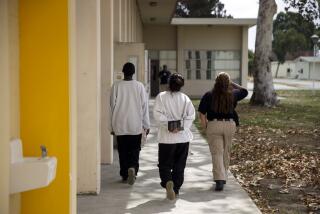Straightening Out Our Crooked Youth : * Early-Identification Plan Would Be Money Well Spent
- Share via
Except for the fact that they were wearing jailhouse blues, the teen-agers gathered last week for a little straight talk about prison life looked as if they could be any group of restless young people being lectured by adults. The boys were slouched on a sofa, not saying much. The girls were more alert--asking questions, offering experiences. And what tales these kids had to tell. For among them were accused murderers, drive-by shooters and narcotics traffickers.
All were locked up at Orange County’s Juvenile Hall in Orange, where on any given day 340 or so young people are pending court action on felonies. These days, so many youngsters are accused of being felons that the hall now turns away mere misdemeanants; they’re sent to probation camps.
Seeing the tough but youthful faces of those who made it to Juvenile Hall is one obvious sign that Orange County needs new approaches to help young people avert a life of crime. Now in the works is a program that would identify youths early on who are in danger of returning to the Hall repeatedly. Hall administrators believe they can bring together such a program partly by reallocating staff. But even if there are added costs, it would save money in the long run if troubled young people could be redirected.
Juvenile Hall administrators say the indicators of future criminals include truancy, poor grades, gang membership, substance abuse and family problems, including abuse and lack of parental supervision or control. Administrators want to target youths that meet at least three of these criteria for special programs, including family counseling.
Exactly what kind of kids might qualify? Juvenile Hall Director Thomas G. Wright gave these examples, all youths being held last week:
--A 14-year-old boy first arrested at age 13 for burglary. Nine months later, he was back at the Hall for shooting into a car that was, unfortunately for him, being driven by undercover cops. An 11-year sentence in California Youth Authority is pending. Juvenile Hall staff would have tagged him for early help because of drug and gang involvement and school problems.
--A 16-year-old boy in Juvenile Hall for his 12th time since age 14, all for narcotics-related offenses. He was involved in drugs and gangs and has many family problems.
--A 16-year-old boy in Juvenile Hall for the 18th time since age 14, the last time for armed robbery. He’s been sentenced to more than four years in CYA. This youth has been involved in gangs and narcotics, did poorly in school and comes from a home with many problems.
Nor were these youths out of the ordinary. One day last week, there were 42 youths in the Hall who had been accused of various murder charges--mostly gang-related. But, even so, administrators say most youths who have a first brush with the law never have a second. Only 8% come back repeatedly, a group that is responsible for about 50% of all activity in the juvenile criminal justice system.
To see the hundreds of young faces at Juvenile Hall is to see how inadequate is a system designed primarily to lock up criminals and throw away the key. These kids are too young to be kept in prison forever, even if society wanted them there. That would be a terrible waste of young lives and public resources.
The questions are: What sort of people will these youths be when they are once again free? And what can be done to keep them out of jail in the first place? A program aimed at early identification of those headed for trouble seems like a good place to begin to look for answers.
More to Read
Sign up for Essential California
The most important California stories and recommendations in your inbox every morning.
You may occasionally receive promotional content from the Los Angeles Times.










